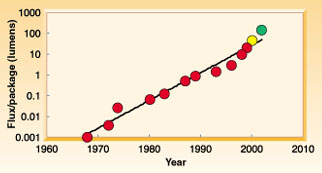
The Future is Bright
OK, so you want one. Badly. We all do. What hope is there for those of us without 50 grand burning a hole in our pocket? We may not work in Film Post Production, or Oil & Gas, but we want HDR in our home cinemas; we want to play Xbox 360 in High Def. HDR.BrightSide Technologies hold all the key patents when it comes the IMLED technology that makes this display tick. They also have patented the process of dynamically adjusting the back light of a display.
The good news is that they are actively talking to all the major manufacturers in an effort to license their technology to as many of them as possible. In fact, we understand that the first such deal has already been signed, though we are left to guess the identity of the "major Far East manufacturer" who has taken the plunge.
With the underlying technology proven, all that remains is to address the issues of LED efficiency, and overall production cost. Right now, we can achieve the desired luminance from these ultra bright, white LEDs but their efficiency - turning current into light - is relatively poor. As a result, they generate a lot of heat, which then has to be dissipated - currently via noisy water cooling.

Alternative Technologies
If we have to wait until 2007, is there anything else that might come close in the meantime?SED Toshiba has been showing a prototype SED (Surface-conduction Electron-emitter Display) display recently. SED is sort of like a flat panel CRT or rather an array of tiny CRTs to make a flat panel. It has very high manufacturing cost and there is one plant coming on line to build it. Toshiba claim a 100,000:1 contrast ratio, however, for this emerging class of HDR displays, contrast ratio becomes much less meaningful.
You can achieve 100,000:1 by simply outputting trivial amount of light out 0.003 cd/m² and then max out at 300 cd/m². Our eyes look at the real world with much higher luminance than that, so SED would require a tenfold increase in peak luminance if it is to compete with BrightSide's technology.
OLED Organic LEDs have been touted as the successor to LCDs for at least a decade now. They are HDR in that they are emissive, so they can go to very low levels of black.
However they are not very bright, and are best suited to small applications, like mobile phone displays. Once you scale up to large sizes, thermal management becomes a problem, dramatically shortening the lifespan, especially the blue channel. Industry experts estimate 5-10 years before they compete with conventional displays.
STOP PRESS Sharp have announced an LCD with a claimed 1,000,000:1 contrast ratio. However, it's peak luminance is just 500 cd/m², meaning all their engineers have done is reduce the minimal luminance as low as 0.0005 cd/m². Of course, BrightSide's approach is superior at both ends of the spectrum: it can delivery 0 cd/m² blacks while simultaneously producing highlights at 4000 cd/m² - eight times the peak luminance of Sharp's LCD.
Final Thoughts
BrightSide are on to a winning formula. By using existing LCD panels as the basic for their display, they can leverage the US$40 billion spent on LCD plants in the Far East in the past four years, and capitalise on an additional US$50 billion due to be invested in the next five years. Alternative technologies such as SED and OLED are expensive to manufacture, unproven in the market and have large technical hurdles to overcome.There is no doubting that HDR is the future - it takes the best HD LCD picture and stomps all over it in clarity, contrast and pure sex appeal. You have seen the pictures, watched the videos, but don't just take our word for it. NVIDIA Chief Scientist, David Kirk, said this in a recent interview:
"I think that High Dynamic Range Lighting is going to be the single most significant change in the visual quality over the next couple of years. It's almost as big as shading... There are new HDR displays that can display a full 16-bit dynamic range, and I can tell you that the difference is stunning. When these displays become more affordable in the next year or two, I don't know how we'll ever go back to the old way." Source: Extremetech
Unfortunately, until production costs can be reduced to affordable levels, this technology will be limited to professional markets like film post production, simulators, game developers, and product design studios.
With any ground breaking product like this, manufacturers are naturally cautious when predicting sales levels. Our job is to make lots & lots of noise, starting with this article's Discussion thread. Show the major players that we all want, nay, demand this technology in our HDTV's as soon as possible.
If you are yet to make the jump to High Definition, we would strongly urge you to consider waiting until HDR models become available, or at least buy today in the knowledge that you will upgrade in 12-18 month's time. It really does make that much of a difference.

MSI MPG Velox 100R Chassis Review
October 14 2021 | 15:04








Want to comment? Please log in.